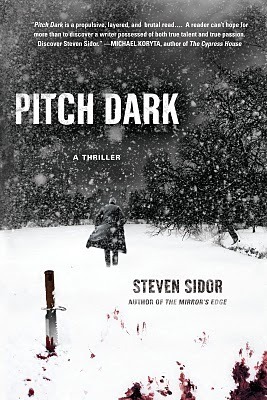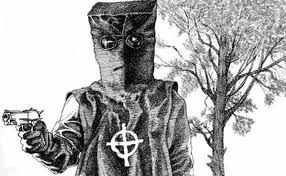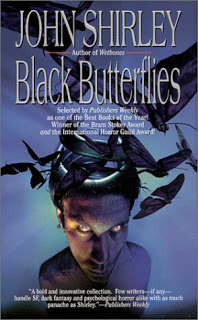Steven Sidor's Blog, page 2
March 1, 2011
Bookclubbing, we're bookclubbing
 Great news! Pitch Dark has been picked up by the Book of the Month Club, Mystery Guild, Science Fiction Book Club, and Quality Paperback Book Club.
Great news! Pitch Dark has been picked up by the Book of the Month Club, Mystery Guild, Science Fiction Book Club, and Quality Paperback Book Club.
Published on March 01, 2011 07:03
February 28, 2011
This is the Zodiac speaking . . .
 During his reign of terror in the late '60s and early '70s, the Zodiac killer attacked three couples in Northern California, killing one man, severely wounding two, and murdering all three women. He also shot and killed a San Francisco cabbie. In total, five people dead. He may have killed more, though the facts aren't clear. But the fascination of the Zodiac killer is not based on body count. It's based on terror. Like Jack the Ripper and the Son of Sam, the Zodiac sent letters and taunted the police. He captured the public's imagination. He made threats about bombs and killing children on a school bus. He also falsely claimed murders he did not commit, perhaps in an effort to confuse authorities or to build up his image and gather more attention. He liked being a media star. He mailed cryptograms peppered with cultural references and purposeful misspellings (only one of the ciphers, the first, was broken). He designed a costume. He changed murder weapons and patterns. He was a thrill killer. A sexual sadist. A keen manipulator. He had intelligence. He was a planner. A game player. And he was never caught. Other infamous serial killers (BTK and the Green River Killer come to mind) lost their horrific auras when the sad, twisted, bland men behind those monikers came into the light. They'd gotten lucky in pursuing their compulsive dark blood fantasies, they evaded the cops, then their luck changed and some combination of DNA and egotism betrayed them and they were caught. Not so with Zodiac. Robert Graysmith makes a compelling argument that Arthur Leigh Allen was Zodiac. The circumstantial evidence against Allen is staggering. But DNA, fingerprints, and handwriting excluded Allen, though the validity of the DNA, fingerprints, and handwriting analysis used to exclude is also debatable. Graysmith's first book, Zodiac, is an excellent study of the case. This Is the Zodiac Speaking: Into the Mind of A Serial Killer by Michael D. Kelleher and David Van Nuys is worth reading as well. Zodiac inspired the movie villain Scorpio in Dirty Harry. David Fincher's beautiful and entertaining film, Zodiac, follows Graysmith's growing obsession with the case and the toll it took on those whose lives were entwined with the crimes. Tom Voigt's website Zodiackiller.com is a treasure trove of information, though Voigt's strong opinions and personality may rub some people the wrong way. Like his predecessor, Jack the Ripper, Zodiac has become a cultural icon. We know the shadow and not the man, the crimes but not the identity of the criminal. He killed and he vanished. He scares us because he is an enigma, an avatar of evil. He was smart, cruel, and powerful. He did what he wanted to do and he got away with it. No closure. We don't have him, so he has us. I suspect he always will.
During his reign of terror in the late '60s and early '70s, the Zodiac killer attacked three couples in Northern California, killing one man, severely wounding two, and murdering all three women. He also shot and killed a San Francisco cabbie. In total, five people dead. He may have killed more, though the facts aren't clear. But the fascination of the Zodiac killer is not based on body count. It's based on terror. Like Jack the Ripper and the Son of Sam, the Zodiac sent letters and taunted the police. He captured the public's imagination. He made threats about bombs and killing children on a school bus. He also falsely claimed murders he did not commit, perhaps in an effort to confuse authorities or to build up his image and gather more attention. He liked being a media star. He mailed cryptograms peppered with cultural references and purposeful misspellings (only one of the ciphers, the first, was broken). He designed a costume. He changed murder weapons and patterns. He was a thrill killer. A sexual sadist. A keen manipulator. He had intelligence. He was a planner. A game player. And he was never caught. Other infamous serial killers (BTK and the Green River Killer come to mind) lost their horrific auras when the sad, twisted, bland men behind those monikers came into the light. They'd gotten lucky in pursuing their compulsive dark blood fantasies, they evaded the cops, then their luck changed and some combination of DNA and egotism betrayed them and they were caught. Not so with Zodiac. Robert Graysmith makes a compelling argument that Arthur Leigh Allen was Zodiac. The circumstantial evidence against Allen is staggering. But DNA, fingerprints, and handwriting excluded Allen, though the validity of the DNA, fingerprints, and handwriting analysis used to exclude is also debatable. Graysmith's first book, Zodiac, is an excellent study of the case. This Is the Zodiac Speaking: Into the Mind of A Serial Killer by Michael D. Kelleher and David Van Nuys is worth reading as well. Zodiac inspired the movie villain Scorpio in Dirty Harry. David Fincher's beautiful and entertaining film, Zodiac, follows Graysmith's growing obsession with the case and the toll it took on those whose lives were entwined with the crimes. Tom Voigt's website Zodiackiller.com is a treasure trove of information, though Voigt's strong opinions and personality may rub some people the wrong way. Like his predecessor, Jack the Ripper, Zodiac has become a cultural icon. We know the shadow and not the man, the crimes but not the identity of the criminal. He killed and he vanished. He scares us because he is an enigma, an avatar of evil. He was smart, cruel, and powerful. He did what he wanted to do and he got away with it. No closure. We don't have him, so he has us. I suspect he always will.
Published on February 28, 2011 06:01
February 25, 2011
UFO: Kecksburg '65
 A fireball streaks across the sky and over Lake Erie. Hundreds of witnesses in multiple Great Lakes states and Canada report the sighting. Traveling southeastward, the object crashes in the woods near the small town of Kecksburg, about thirty miles from Pittsburgh. Local citizens, reporters, and emergency responders, thinking a plane has crashed, instead encounter a large and almost immediate US military presence in the area of the crash. A few witnesses get close enough to see broken trees, smoke, and flashing blue lights. Local news director, John Murphy, photographs the downed object and tape-records eyewitness statements. The area is cordoned off. Later that night, a military truck leaves the woods, carrying an acorn- or cone-shaped object about the size of a Volkswagen on its flatbed. Several people notice strange symbolic writing around the edge of the object. The military insists nothing crashed in the woods; later they say a meteor landed. In 2005 NASA will claim the object was a Russian satellite. John Murphy puts together a radio documentary about the incident. Before the show can air, he's visited by two men. He turns over some of his tapes and he edits his documentary to reveal no new information to the public. Afterward, he refuses to discuss the incident. He's killed by a hit-and-run driver while vacationing in California.
A fireball streaks across the sky and over Lake Erie. Hundreds of witnesses in multiple Great Lakes states and Canada report the sighting. Traveling southeastward, the object crashes in the woods near the small town of Kecksburg, about thirty miles from Pittsburgh. Local citizens, reporters, and emergency responders, thinking a plane has crashed, instead encounter a large and almost immediate US military presence in the area of the crash. A few witnesses get close enough to see broken trees, smoke, and flashing blue lights. Local news director, John Murphy, photographs the downed object and tape-records eyewitness statements. The area is cordoned off. Later that night, a military truck leaves the woods, carrying an acorn- or cone-shaped object about the size of a Volkswagen on its flatbed. Several people notice strange symbolic writing around the edge of the object. The military insists nothing crashed in the woods; later they say a meteor landed. In 2005 NASA will claim the object was a Russian satellite. John Murphy puts together a radio documentary about the incident. Before the show can air, he's visited by two men. He turns over some of his tapes and he edits his documentary to reveal no new information to the public. Afterward, he refuses to discuss the incident. He's killed by a hit-and-run driver while vacationing in California.
Published on February 25, 2011 16:01
February 23, 2011
Used & Abused: Don't Call Me Shirley
 Most of my favorite horror short story writers have connections to the state of California. Fritz Leiber, Richard Matheson, Richard Laymon, Michael Shea, Dennis Etchison, Clive Barker, David J. Schow, John Shirley . . . I don't know what it is exactly, but there's an energy, a friction that really throws off sparks. And for all the variety in their voices, each of these writers transmits a vibe that cuts to the bone and scares me. I read a ton of horror stories, and I forget most of them. One of the truest tests of quality is how long a story burns in your memory. In my case, the record for memory-burns in one collection is a tie between Dennis Etchison's Dark Country and John Shirley's Black Butterflies. Shirley's voice is his and his alone. He possesses a rawness, an edge, and the ability to shock a reader into and out of reality with a sentence or two. He's crude, gross, funny, and erotic. He mines the kinky druggy outcast fringes. His work is both surreal and hyper-real. The best thing about him? I believe everything he writes. I'm there in the bedroom or on the street, side-by-side with his characters, and when the pain, horror, weirdness, and violence hits -- I feel it in my gut. Don't mistake pure power for a lack of skills. Shirley is a stark craftsman who packs more punch into less space than most poets, and because his characters often use the language of the streets it's easy to forget who's feeding them their lines. Black Butterflies contains between its covers my favorite crime story, a tale of two dirty cops, called "War and Peace." You'll also find the most visceral, claustrophobic tale of a natural disaster, "Cram," and trippy shapeshifting gems like "Pearldoll" and "Aftertaste." John Shirley gets inside your head and messes you up. Try him and see if you don't get hooked.
Most of my favorite horror short story writers have connections to the state of California. Fritz Leiber, Richard Matheson, Richard Laymon, Michael Shea, Dennis Etchison, Clive Barker, David J. Schow, John Shirley . . . I don't know what it is exactly, but there's an energy, a friction that really throws off sparks. And for all the variety in their voices, each of these writers transmits a vibe that cuts to the bone and scares me. I read a ton of horror stories, and I forget most of them. One of the truest tests of quality is how long a story burns in your memory. In my case, the record for memory-burns in one collection is a tie between Dennis Etchison's Dark Country and John Shirley's Black Butterflies. Shirley's voice is his and his alone. He possesses a rawness, an edge, and the ability to shock a reader into and out of reality with a sentence or two. He's crude, gross, funny, and erotic. He mines the kinky druggy outcast fringes. His work is both surreal and hyper-real. The best thing about him? I believe everything he writes. I'm there in the bedroom or on the street, side-by-side with his characters, and when the pain, horror, weirdness, and violence hits -- I feel it in my gut. Don't mistake pure power for a lack of skills. Shirley is a stark craftsman who packs more punch into less space than most poets, and because his characters often use the language of the streets it's easy to forget who's feeding them their lines. Black Butterflies contains between its covers my favorite crime story, a tale of two dirty cops, called "War and Peace." You'll also find the most visceral, claustrophobic tale of a natural disaster, "Cram," and trippy shapeshifting gems like "Pearldoll" and "Aftertaste." John Shirley gets inside your head and messes you up. Try him and see if you don't get hooked.
Published on February 23, 2011 07:12



